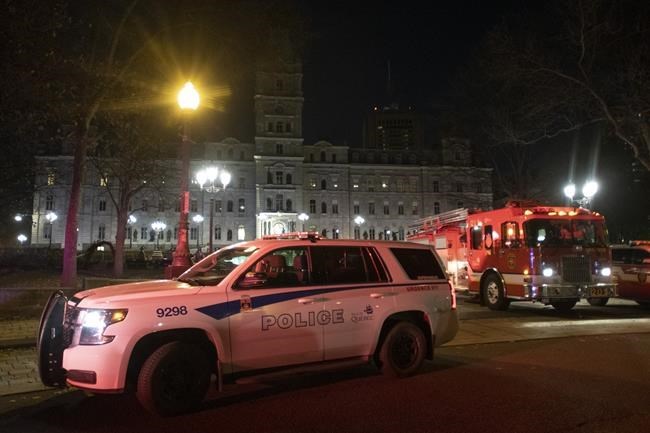QUEBEC — Lawyers made their final arguments to the jury in the Quebec City Halloween murder trial on Wednesday, with deliberations on the fate of the accused expected to begin next week.
Carl Girouard has admitted to using a Japanese-style sword called a katana, with a 76.9-centimetre blade, to kill and maim on Oct. 31, 2020, but he has maintained he was not criminally responsible because he suffered from a mental disorder.
Girouard, 26, is charged with two counts of first-degree murder in the stabbing deaths of François Duchesne, 56, and Suzanne Clermont, 61. He is also charged with five counts of attempted murder in the attack in the city's historic Old Quebec district.
Defence lawyer Pierre Gagnon told jurors his client should be found not criminally responsible, insisting on the findings of Dr. Gilles Chamberland, a psychiatrist who concluded after assessing Girouard that the accused suffered from schizophrenia, was on the autism spectrum and was in psychosis the night of the killing.
Even if autism did not contribute to the murders, it camouflaged the appearance of schizophrenia in Girouard to his family, Gagnon told jurors.
Gagnon attacked the credibility of the two experts called by the prosecution, psychiatrist Dr. Sylvain Faucher and neuropsychologist William Pothier. Both rejected the thesis that the defendant suffered from schizophrenia at the time of the murders.
Faucher concluded Girouard was not schizophrenic or psychotic but instead had a narcissistic personality disorder and knew right from wrong.
Gagnon told jurors that Faucher "had an answer to everything. And by dint of giving an answer to everything, he also gave you examples that were shaky."
Girouard took the stand in his defence during the trial, testifying that he had hatched a mission by the time he was 18. He said his mission involved killing people with a sword, creating chaos, changing the world and encouraging like-minded people — whom he called his "alter-egos" — to continue his mission after his death.
He had first discussed the mission with mental health workers at his school in 2014 and 2015.
The accused testified there were two competing versions of himself: one that exists in the present and the "bad" version that was mission-focused and who ceased to exist after the Halloween attacks.
For his part, prosecutor François Godin, who has maintained Girouard's actions were premeditated, said the defence had failed to prove Girouard was suffering from mental illness.
"Do you believe that Carl Girouard, who is obsessed by this mission for six years, will execute the mission, exit his psychosis with a snap of his fingers and never again think of the mission — never again speak of the mission that obsessed him for six years, and this, without any antipsychotic medication?" Godin asked the 11 jurors.
Godin asked jurors how the accused, who presented no signs of psychosis after his arrest, could have miraculously been cured, noting that schizophrenia is an illness that is treatable but has no cure.
Justice Richard Grenier said he will begin his instructions to the jury on Thursday and will wrap them up on Monday, after which they will be sequestered until they come back with a unanimous verdict.
This report by The Canadian Press was first published May 11, 2022.
— with files from Frédéric Lacroix-Couture in Montreal.
This story was produced with the financial assistance of the Meta and Canadian Press News Fellowship.
The Canadian Press



